March 13, 2009
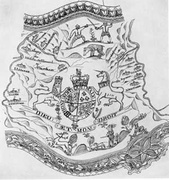
This article, written by the then-Curator of Arms and Armor at the Metropolitan Museum of Art in New York, discusses powder horn maps of the 1700s. Powder horn maps served not only as maps but as forms of self-expression, each created by the individual and representing his personal story, thus a perfect example of American folk art. It originally appeared in the July 1939 issue of American Collector magazine, a publication which ran from 1933-1948 and served … (continue reading)
March 12, 2009
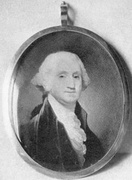
This article is about popular jewelry made in the late-18th and 19th centuries to commemorate George Washington, such as rings, lockets, and brooches – some of which even included pieces of his hair. It originally appeared in the February 1939 issue of American Collector magazine (Volume VII Number 12), a publication which ran from 1933-1948 and served antique collectors and dealers.
The fashion for personal adornment with memorials of recently deceased relatives or of persons held in particular esteem … (continue reading)
March 10, 2009
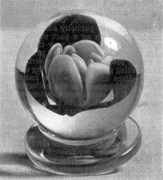
The following article focuses on Millville paperweight-making in the 20th century, especially the owner’s struggles with the rose design. It also details other popular designs that Millville artists created, such as fire-devil and lily, and explains how paperweights are made. It originally appeared in the December 1938 issue of American Collector magazine (Volume VII Number 11), a publication which ran from 1933-1948 and served antique collectors and dealers.
Victor Durand, owner and operator of this Vineland plant, never owned … (continue reading)
March 9, 2009
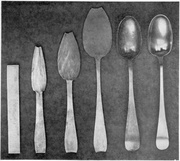
This article describes how early American silversmiths made sterling silver spoons, from melting metal to casting to rolling, annealing, hammering, and honing. It originally appeared in the January 1939 issue of American Collector magazine (Volume VII Number 12), a publication which ran from 1933-1948 and served antique collectors and dealers.
Under the patient probe of research, our silversmiths have emerged as definite personalities. They were men of many interests, prominent in their communities, and the number of … (continue reading)
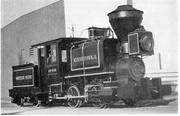
The following piece describes an early effort to salvage, restore, and preserve old American steam railroad locomotives, circa 1893, at the time of the Chiago World’s Fair. It originally appeared in the May 1939 issue of American Collector magazine (Volume VIII Number 4), a publication which ran from 1933-1948 and served antique collectors and dealers.
In the final analysis, collecting of old locomotives is not essentially different from the collecting of early carriages, clocks, pewter cups, or Sheffield knives. … (continue reading)

The following piece focuses on clockmakers in the U.S. and Europe in the 18th and 19th centuries, specifically the marks and materials they used and the regulations that were placed on them. It originally appeared in the December 1940 issue of American Collector magazine (Volume IX Number 11), a publication which ran from 1933-1948 and served antique collectors and dealers.
Tall case clocks represented two crafts; that of the clockmaker who worked in metal and that of the … (continue reading)
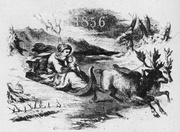
The following piece tells the story of how Santa Claus came to be, from his debut in 1844 to his evolution from New Year’s icon to beloved symbol of Christmas. It originally appeared in the December 1939 issue of American Collector magazine (Volume VIII Number 11), a publication which ran from 1933-1948 and served antique collectors and dealers.
Santa Claus made the front page in 1844. In that year his likeness appeared in The New Mirror, … (continue reading)
February 26, 2009

The following piece details the establishment of the Worcester china manufacturers in 1751 by a small group of men hoping to bring economic stability to their town of Worcester, as well as the pottery’s evolution during its early years, which was influenced by changes in ownership. It originally appeared in the January 1939 issue of American Collector magazine (Volume VII Number 12), a publication which ran from 1933-1948 and served antique collectors and dealers.
Is business bad? Is … (continue reading)








 Get Into Costume: Henry Schreiner Brooch
Get Into Costume: Henry Schreiner Brooch Space Oddity: David Bowie's Secret Obsession With '80s Memphis Design
Space Oddity: David Bowie's Secret Obsession With '80s Memphis Design How Snake Oil Got a Bad Rap (Hint: It Wasn't The Snakes' Fault)
How Snake Oil Got a Bad Rap (Hint: It Wasn't The Snakes' Fault)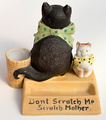 Stranger Than Friction: When Matches Were Dangerous, Vestas Kept Us Safe
Stranger Than Friction: When Matches Were Dangerous, Vestas Kept Us Safe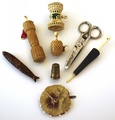 Royalty, Espionage, and Erotica: Secrets of the World's Tiniest Photographs
Royalty, Espionage, and Erotica: Secrets of the World's Tiniest Photographs Mari Tepper: Laying it on the Line
Mari Tepper: Laying it on the Line Nice Ice: Valerie Hammond on the Genteel Charm of Vintage Canadian Costume Jewelry
Nice Ice: Valerie Hammond on the Genteel Charm of Vintage Canadian Costume Jewelry How Jim Heimann Got Crazy for California Architecture
How Jim Heimann Got Crazy for California Architecture Modernist Man: Jock Peters May Be the Most Influential Architect You've Never Heard Of
Modernist Man: Jock Peters May Be the Most Influential Architect You've Never Heard Of Meet Cute: Were Kokeshi Dolls the Models for Hello Kitty, Pokemon, and Be@rbrick?
Meet Cute: Were Kokeshi Dolls the Models for Hello Kitty, Pokemon, and Be@rbrick? When the King of Comedy Posters Set His Surreal Sights on the World of Rock 'n' Roll
When the King of Comedy Posters Set His Surreal Sights on the World of Rock 'n' Roll How One Artist Makes New Art From Old Coloring Books and Found Photos
How One Artist Makes New Art From Old Coloring Books and Found Photos Say Cheese! How Bad Photography Has Changed Our Definition of Good Pictures
Say Cheese! How Bad Photography Has Changed Our Definition of Good Pictures Middle Earthenware: One Family's Quest to Reclaim Its Place in British Pottery History
Middle Earthenware: One Family's Quest to Reclaim Its Place in British Pottery History Fancy Fowl: How an Evil Sea Captain and a Beloved Queen Made the World Crave KFC
Fancy Fowl: How an Evil Sea Captain and a Beloved Queen Made the World Crave KFC